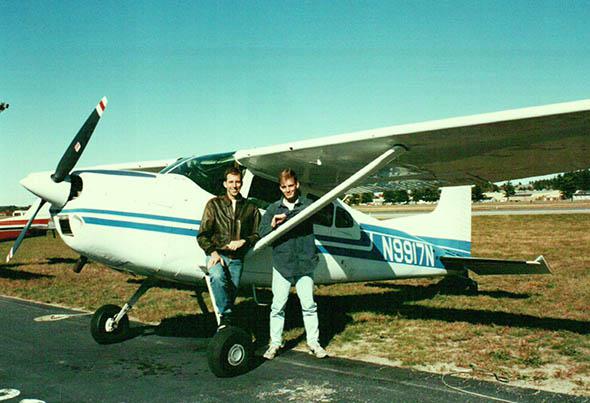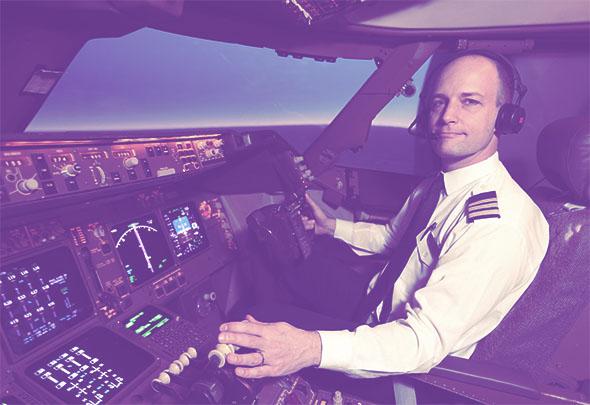All week, Mark Vanhoenacker has been sharing stories about piloting and planes excerpted from his book Skyfaring: A Journey With a Pilot, out now from Knopf. In what follows, the Slate staff ask Mark to answer their own questions about flying.
Andrew Kahn, assistant editor: Do pilots appreciate it when passengers clap after landing? Is this a recent phenomenon, or has it been going on for a while?
Mark Vanhoenacker: From the cockpit of the 747 we don’t usually hear the applause—we are upstairs, of course, and wearing some seriously pricey noise-canceling headsets—so we only hear about applause later, when the cabin crew tell us about it once we’ve parked at the gate.
Having said that, as a cultural phenomenon, this definitely deserves a Slate piece, I think. In my experiences as a passenger, and as a pilot who hears about it after a flight, clapping is associated with two different situations.
One, when there’s a large group of people traveling together, especially young people. I regularly fly from London to the U.S. or Canada, and we carry large school groups. They’re obviously excited—for many it’s likely to be their first long-haul trip—and given that they’re typically sat together in one section of the cabin, and young, and happy, I guess it’s not surprising that applause erupts more or less naturally on touchdown. I don’t ever hear about it on the way back to Europe, when they’re at the end of their trip and maybe sleepy after an overnight flight.
I also witness applause when I’m flying as a passenger in countries where flying has grown rapidly in recent years. I’m thinking mostly of Brazil here. I don’t know if that’s because flying is more likely to be a new experience to passengers on domestic flights there, or if the applause reflects a more general cultural characteristic. I also notice on flights within Brazil that many more passengers are staring out the window than you’d expect on a domestic U.S. flight. It might be that flying still seems new for many travelers there. Or maybe it’s just that Brazil looks particularly good from the air.
Chad Lorenz, news editor: How do pilots spend their time when a plane is on autopilot?
Vanhoenacker: The autopilot is typically engaged for the cruise portion of a long flight.
During that time we’re still pretty busy making radio calls and position reports, checking our route, uploading new wind data to optimize our flight path, conducting fuel checks, and of course looking out the windows to observe aircraft on adjacent airways or nearby at different altitudes. There are some areas of the world where weather systems can extend up to our cruising altitude, and we may fly around clouds in a kind of hybrid of manual and automatic flying that’s not always well-understood outside the cockpit. So we’re directing the path of the plane using our eyes and the scans from the weather radar, but to do so we’re dialing new headings on the autopilot, rather than physically turning the plane ourselves.
But at night, especially over the ocean where there are not going to be short-haul aircraft in the skies, things are often quite peaceful. I love the feeling that nearly everyone on the plane is asleep, and here we are in the darkened cockpit, looking out at the moonlight on the sea—it’s the kind of moment that I didn’t know about before I became a pilot. If I had, I might have started my training sooner.
On long flights we may have three or four pilots, which means that one or two of us are able to take an extended break. On an overnight flight I’ll go straight to sleep in the 747’s bunk, a separate little bedroom inside the cockpit that’s insulated from sound and light. I sleep very well there. On a day flight I might have a meal, take a picture or two from the window, then have a nap for a couple hours.
Ben Mathis-Lilley, Slatest editor: How bad does turbulence have to get before the flight crew is concerned about it? Flight attendants are always so calm even when it gets bad.
Vanhoenacker: Planes are engineered to extraordinarily rigorous standards, and cabin crew, like pilots, know that turbulence is uncomfortable but never dangerous.
For us in the cockpit, the main concern is that we don’t want our customers to be moving about the cabin at such times, which is why we’ll put the seatbelt sign on. And of course, we want the flight to be as smooth as possible, especially if it’s an overnight flight and passengers will be trying to sleep.
Alison Griswold: What are pilots afraid of, if anything? How do their worries differ from what passengers are anxious about?
Vanhoenacker: I don’t mean to sound flippant, but the more I fly, the more amazed I am that motorists are allowed to pilot their 2-ton machines along highways, barely separated from adjacent speeding vehicles, maintaining whatever distance they feel like from the car in front, in whatever weather they feel like driving through. If someone proposed the current road system from scratch, I’m sure it would never be allowed. The contrast between that and the highly regulated, highly separated, radar-controlled environment of commercial aviation couldn’t be greater.
Heather Schwedel, copy editor: What are your favorite depictions of flying and pilots in movies?
Vanhoenacker: I really like Airplane!—I think many pilots love that movie, and it is a seemingly inexhaustible font of humor in the cockpit. I also love the flying scenes in Out of Africa, but more perhaps because they remind me of the amazing passages in the book that describe flight.
Once I flew with a captain just after the movie Snakes on a Plane came out. Before departure he told me he was a trained wild animal handler. I thought he was joking and then he showed me pictures of him in South Africa with lions.

Photo courtesy Mark Vanhoenacker
Schwedel: What flights do you prefer to take when you fly somewhere as a passenger?
Vanhoenacker: Two of my favorite airports to arrive at are Los Angeles and London Heathrow. I love to fly into LAX at dusk. Coming from the northeast, you have this quite majestic sense of a country quickening toward its geographic terminus—the roads get wider, the Mojave turns to suburbs, then you have this ring of typically snow-capped peaks, then a sea of light and beyond it the Pacific itself. London–Los Angeles is no longer on the 747—it’s one of the reasons I might switch to the Airbus A380 in a few years.
At Heathrow, if the wind is from the west, you’ll fly right over central London as you make your approach. You’ll see Canary Wharf, Tower Bridge, the London Eye, Westminster, Green Park, Kew. Make sure to ask for a window seat on the right side. There’s that modern myth that the word posh stands for “port out, starboard home,” for seafaring travelers to ensure they got the shady side on boats sailing between Britain and India. “Starboard home” is still good advice for passengers flying back to London.
Rachael Larimore, senior editor: Everyone complains about how awful air travel is these days. What is better about flying today, from a pilot’s point of view?
Vanhoenacker: I think I’m a bit of a geek when it comes to technology, and personally I’m quite excited about the prospect of flying a new aircraft like the Boeing 787 or the Airbus A350. I went onto the flight deck of a 787 last year, and it looks like the Starship Enterprise. And it’s a lovely airplane from the outside, too. To have the chance to fly some of those most advanced machines our species has ever made is quite a thrill, and the next few years look great.
We also appreciate many of the same things that passengers might. It wasn’t so long ago that at some airports you could get on a plane without actually seeing the aircraft itself. I think newer terminals are now being designed specifically to reintegrate the airplanes into the travel experience. My home base is Heathrow’s Terminal 5. It’s basically a large glass box built to let air travelers watch the air show going on all around them.
And speaking of new airplanes, the Boeing 787 has enormous windows in the passenger cabin, much bigger than on other airliners, which means it’s quite hard to forget about what you’re actually doing when you get on one to go across the world. Also, there are no window blinds; the windows dim electrically, and the last bit of dimming is controlled by the passenger. So if you want to look out at the Rockies and your traveling companion wants it to be dark enough to sleep, no problem.
Larimore: Do airlines pad flight times so that they can boost their “on-time arrival ratings”? I feel like they do.
Vanhoenacker: I would look at it the other way: It would be unrealistic to simply include the flight time when telling customers how long their journeys will take. By including the expected taxi-out time, flight time, and taxi-in time at the far end of the journey, travelers know when they can expect to walk off the airplane at their destinations. And it’s important for those times to be realistic, so at a busy time of day or a busy day of the week at certain airports, those times will be longer.
June Thomas, Outward editor: Is there a particular political bent among pilots?
Vanhoenacker: I don’t think that there’s a particular political bent, but I do think pilots are a pretty “worldly” bunch—if you’ll excuse the perhaps inevitable term. It’s a very multicultural job in the sense that we are working with colleagues and customers from all over the world. People are very open-minded, and there’s a strong focus on getting the best out of a team, even if you’ve never met the individuals on it before. Various other professions have taken lessons from aviation—Atul Gawande’s excellent book on checklists comes to mind—and I think there’s another book to be written about the lessons to be learned from an industry that was “globalized” long before there was a word for it.
Laura Helmuth, science editor: Do you pack your own lunch, or do you eat airplane food?
Vanhoenacker: I like the food we serve on board. We’re given a separate menu, and sometimes we will have a main course that’s left over from Club (business class). Contrary to popular belief, we don’t eat first-class food—passengers can order whatever they like, whenever they like, so (unfortunately for the crew) nothing is really “left over” until we land.
I do like to carry my own snacks with me. Oranges for some reason taste very good at high altitude—maybe it’s the freshness of the citrus. I also take bags of nuts with me and a banana or two on a long overnight flight, as I’m not usually interested in a big hot breakfast before landing. I always take that food out of my bag when I get on board and store it in a side cupboard, just to make sure I don’t accidentally take fruit into a country that prohibits it.
Helmuth: Do you ever see whales?
Vanhoenacker: I have never seen a whale from an airplane, but I heard a great story from a reader of the book in the U.K., about a day that they were out on a whale watch. I think they said they were off of Boston, but maybe it was Cape Town. As they were in the middle of a pod of whales, a 747 flew right overhead, bound for Logan Airport I guess (if it was Boston) and the reader reported that the passengers on the boat all pointed their cameras upward at the giant in the sky.
